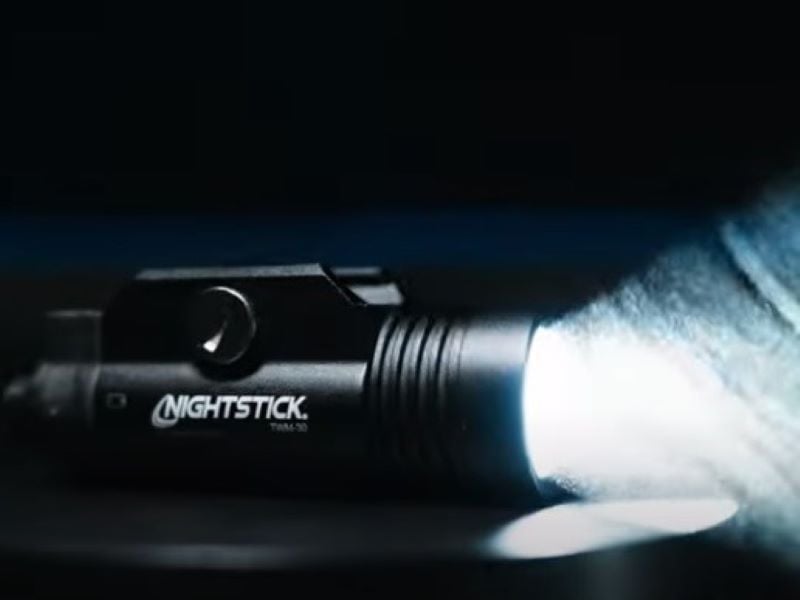A weapon-mounted light should not take the place of having a dedicated handheld unit, but when it comes to having to actually use your firearm in a low-light environment, having a weapon light gives you an edge. One of the biggest hurdles when it comes to choosing the right light. Some lights can cost more than the firearm you are looking to outfit, but the cheapest units will simply stop working under recoil. Outside the bottom tier, you are probably considering a light from Surefire, Streamlight, or Nightstick. These manufacturers produce a quality light with plenty of models to choose from. But which one is best for you? Jeremy from GMW tested a sample from all three makers to compare their respective features and demonstrate their brightness and identifying ability.

Comparative Features
Jeremy selected a popular model from each brand of weapon light: the Surefire X300U-A, Streamlight TLR-1HL, and the Nightstick TWM-30. There is plenty of similarity between each of these models. All come in at under five ounces and use an aluminum housing. All of them have an ambidextrous strobe and constant on/off feature as well as an IPX7 waterproof rating. But that is where the similarity ends.
The Surefire X300U-A is the most expensive of the lot, coming in at $329 retail. It uses CR123A batteries and has a life of 1 hour and 15 minutes at 1000 maximum lumens and 11,300-candela brightness. The beam’s range is 233 yards.
The Streamlight costs only $160 and has the same battery setup but it has the same lumens as the Surefire. But the battery life is a tad longer: 1.5 hours. The candela measurement is 20,000 with a substantially longer beam range of 309 yards.
The Nightstick TWM-30 has a life of 1 hour and 45 minutes. It has a maximum output of 1,200 lumens, but the same candela rating as the Surefire with a shorter range of 194 yards.
Up Close
Lumens, candela ratings, and beam range give us an idea of the strength, range, and narrowness of light, but what does it mean practically? Jeremy took all three lights to his blacked-out pistol range. He set out three targets separated from one another in six-foot intervals at a distance of seven yards.
From that distance, the Surefire had a strong center beam that illuminated the intended target with enough of a flood to have a peripheral illumination to see the targets on either side of the intended target. But there was no clear distinction between the beam and the flooded light as it visually looked like an indifferent stream.
The Streamlight performed similarly to the Surefire on the primary target but there was a noticeably brighter flood onto the secondary targets. This is helpful in situations where the intended target of your attention is accompanied by others. It pays to not only see them but have enough light to watch their movements.
The Nightstick was noticeably brighter than the Surefire, but not as much as the Streamlight, as the candela rating would suggest. But there is a clear beam of light on the intended target and a halo around it that gives ample illumination of the peripheral targets.
Far Out
Most weapon-mounted lights are intended for pistols, so they tend to be shorter-range propositions. Yet all of the lights tested have a beam rating in excess of typical pistol shooting distances. Jeremy took the lights to a back lot with plenty of distance as well as backlighting from surrounding buildings that can play with our vision and the performance of flashlights.
Jeremy had an assistant standing in the darkness at 100 yards and he proceeded to detect him with the lights. The Streamlight was the overall brightest light, but overall, all three could illuminate the general area of the target but not enough to identify the target as a threat.

At 50 yards, Jeremy’s assistant can easily be seen by all lights, although the Nightstick gave off a bluish hue compared to the others. At this range, it was also easy to see peripheral objects like a soda can.
The Big Picture
The Streamlight has the edge in brightness at distance, while the Nightstick has it at closer distances. The Surefire, however, was not far behind in performance. But raw illuminating power is not everything, as Jeremy explained.
The Surefire design has been around the longest and has an articulating button to switch on/off. It also has an uncomplicated hinged latch to open the battery compartment for servicing.
The Streamlight opens up for new batteries the same way, but it uses co-dependent levers to activate that are easy to bump. In practice, Jeremy tended to bump the levers and turn the light on when it was not needed. A new shooter might also be confused about which direction to push the lever to get the desired result.
The Nightstick requires a screwdriver to remove a battery cover for changing, but that is offset by how the light is activated. It has two independent levers on either side of the light that can be moved or pushed in. Pushing and holding will give you a temporary on while pushing and letting go will give you a permanent beam.
While issues like these might not be consequential with enough training, it does pay to keep it simple and look beyond the numbers in the catalog when deciding what light is best for you.

